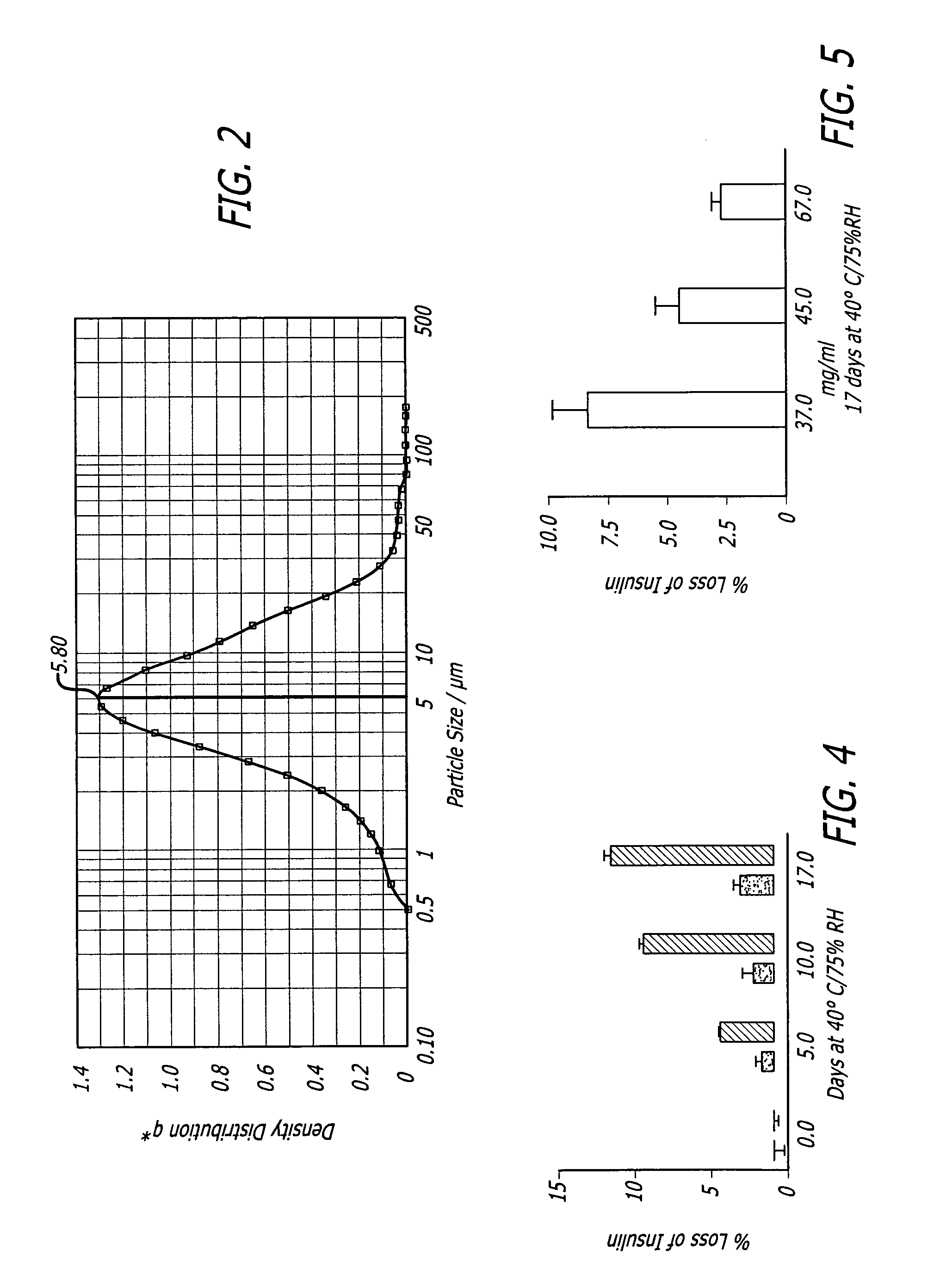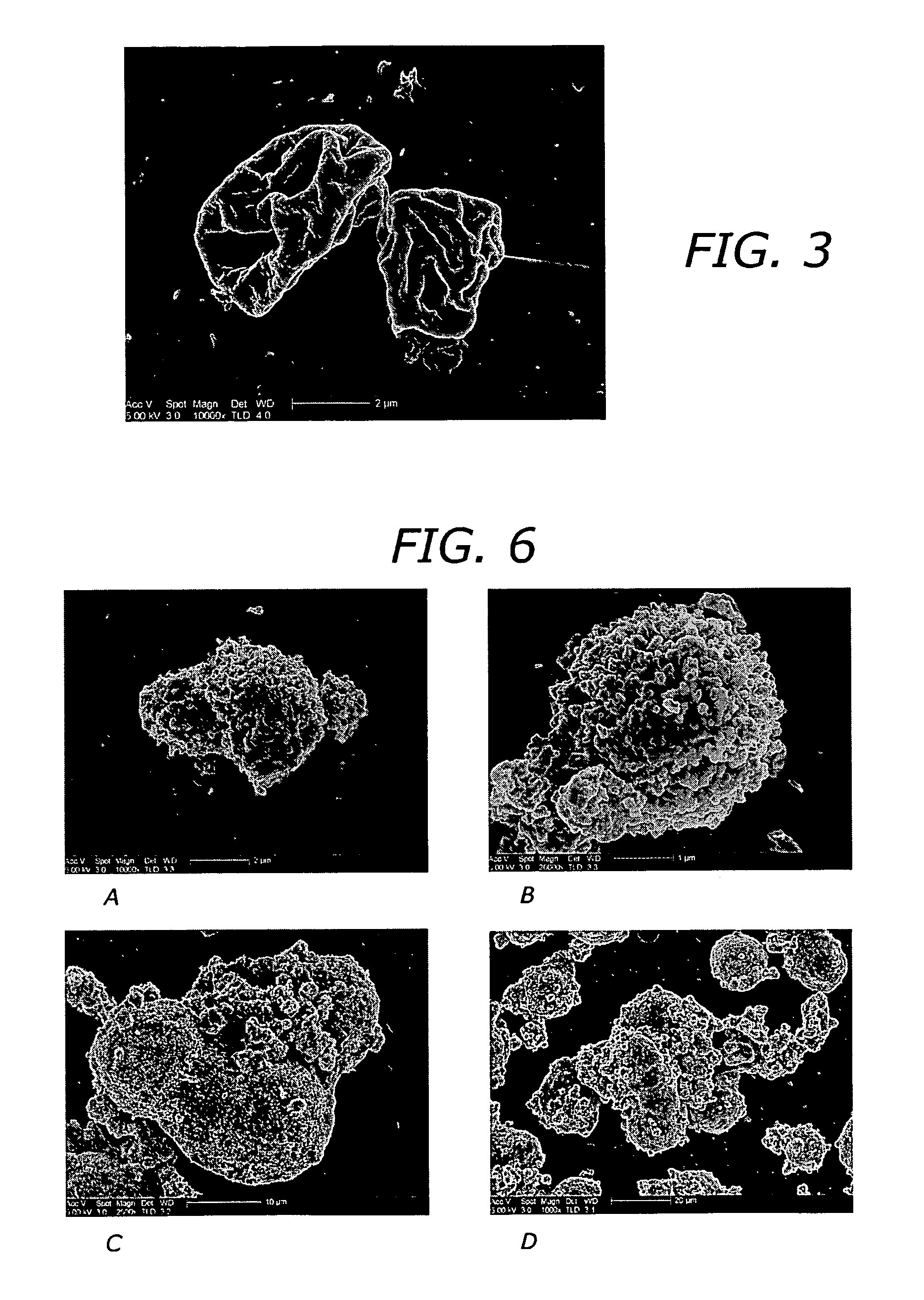Diketopiperazine salts for drug delivery and related methods
a technology of piperazine salts and drug delivery, applied in the field of piperazine salts, can solve the problems of persistent challenge and difficulties in drug delivery
- Summary
- Abstract
- Description
- Claims
- Application Information
AI Technical Summary
Benefits of technology
Problems solved by technology
Method used
Image
Examples
example 1
Preparation A of FDKP Disodium Salt
[0088]Thirteen grams of fumaryl diketopiperazine (FDKP) (28.73 mmol, 1 equiv.) were placed into a 250 mL 3-neck round bottom flask equipped with a reflux condenser, magnetic stir bar, and thermometer. The reaction was run under a nitrogen atmosphere. Water (150 mL) and 50% sodium hydroxide (4.48 g, 1.95 equiv.) were added sequentially to the flask. The resulting yellow solution was heated to 50° C. and held for 2 hours. The solution was then hot filtered to remove any insoluble material. The water was removed from the sample via rotary evaporation. The recovered solids were dried in the vacuum oven (50° C., 30 inches of mercury) overnight. The salt was then assayed for moisture content (Karl Fischer) and sodium content (elemental analysis and titration). The yield of the salt was from about 90% to about 95%.
[0089]
Molecular Formula: C20H26N4Na2O8.1.4809 H2O% Water by Karl Fischer titration: 5.1%Elemental Analysis:CalcC 45.92H 5.58N 10.71Na 8.79Found...
example 2
Preparation B of FDKP Disodium Salt
[0091]Thirteen grams of FDKP (28.73 mmol, 1 equiv.) and ethanol (150 mL) were placed into a 250 mL 3-neck round bottom flask equipped with a reflux condenser, magnetic stir bar, and thermometer. The reaction was run under a nitrogen atmosphere. The slurry was heated to 50° C. Sodium hydroxide, 50% w / w aqueous solution (4.71 g, 2.05 equiv.) was added in one portion. The resulting slurry was held at 50° C. for 2 hours. The reaction contents were then cooled to ambient temperature (20-30° C.) and the solids isolated by vacuum filtration. The recovered salt was washed with ethanol (300 mL) and acetone (150 mL) and dried in the vacuum oven (50° C., 30 inches of mercury) overnight. No further purification was required. The salt was then assayed for moisture content (Karl Fischer) and sodium content (elemental analysis and titration). The yield of the salt was from about 90% to about 95%.
[0092]
Molecular Formula: C20H26N4Na2O8.1.4503 H2O% Water by Karl Fis...
example 3
Preparation A of FDKP Dilithium Salt
[0094]Ten grams of FDKP (22.10 mmol, 1 equiv.) and 100 mL of water were placed into a 200 mL 3-neck round bottom flask equipped with a reflux condenser, magnetic stir bar, and thermometer. The reaction was run under a nitrogen atmosphere. In a separate flask, an aqueous solution of lithium hydroxide (1.81 g, 1.95 equiv.) in 40 mL of water was prepared. Once all of the lithium hydroxide had dissolved, this solution was added in one portion to the aqueous slurry of FDKP. The resulting solution was heated to 50° C. and held for 1 hour. The reaction contents were then cooled to ambient temperature and filtered to remove any undissolved particles. The water was removed from the sample via rotary evaporation. The recovered solids were dried in a vacuum oven (50° C., 30 inches of mercury) overnight. The salt was then assayed for moisture content (Karl Fischer) and lithium content (elemental analysis and titration). The yield of the salt was about 98%.
[00...
PUM
| Property | Measurement | Unit |
|---|---|---|
| diameter | aaaaa | aaaaa |
| diameter | aaaaa | aaaaa |
| diameter | aaaaa | aaaaa |
Abstract
Description
Claims
Application Information
 Login to View More
Login to View More - R&D
- Intellectual Property
- Life Sciences
- Materials
- Tech Scout
- Unparalleled Data Quality
- Higher Quality Content
- 60% Fewer Hallucinations
Browse by: Latest US Patents, China's latest patents, Technical Efficacy Thesaurus, Application Domain, Technology Topic, Popular Technical Reports.
© 2025 PatSnap. All rights reserved.Legal|Privacy policy|Modern Slavery Act Transparency Statement|Sitemap|About US| Contact US: help@patsnap.com



